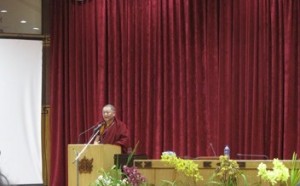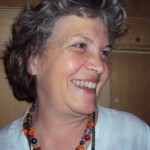
As we moved into the topic Understanding Mind, Robert Thurman, Director of Buddhist Studies at Columbia University gave an outline of the workings of mind in lay Buddhist terms, and spoke of Buddha as scientist, spiritual teacher and educator. In his view Buddhism is a sophisticated depth psychology, as Buddha discovered the subconscious a millennia before Freud. Karma, he said, precedes Darwin by 2400years. Thurman described Buddhism as a field of transformative psychologies, ethical systems with a realistic world view that support naturalistic internalisation, where epistemology is strongly developed and contemplative methodologies are finely attuned to all types of person. He said the distinctive speciality is in the formation of the art of identity with a crucial deconstruction and creative construction of what makes us who we are. (My italics)
In particular, Thurman elucidated in didactic terms what he called the Buddha’s ‘keys to discovery’ giving an analogy of the cause of suffering, its arising and cessation, the obstacles that prevent happiness and the way forward.
For example the Path of Super Education can be described thus : Everything is science based – that is – free wisdom knowledge which penetrates everything.
A realistic (right) world view as engaged realism. Education must embrace causes, because all things arise from causes and it must explore what they are, what is their cessation. Western culture includes nihilistic material concepts, these are being adopted by Asians, however by taking this scientific view, he said, gives room for secular ethics, because while the Buddha was anti religious, he was at the heartbeat of every being, and this is true compassion.
The next speaker, Professor Garfield spoke from the perspective of cognitive science, reminding us that scientists have discovered that meditation techniques are quantifiable, that the brain does something when the mind does something and although this was understood by meditators, it was not reported until science came along. So it is science that has reported the breakthroughs, that has made the controlled experiments, or has created the tools for measurement. On the surface we have created contours for our cognitive lives and also are able to observe the deep fundamental processes. In his role as respondent to Garfield, Geshe Dorje Damdul (one time translator for His Holiness the Dalai Lama) offered that in his view, science narrowly confines mind as an object of analysis, saying that Buddhism has a much broader schemata for describing aspects of mind : the evident, the slightly hidden, and the absolutely hidden. There is, he says, an ‘explanatory gap’ and if there were to be truth in the ‘mind only ‘ school which says that everything is a projection of mind, then why are there not as many worlds as there are minds? B Alan Wallace picked up on this later when he asked if we could see the fruit he was visualising, pointing out that even science has no way to measure or monitor that; it remains absolutely hidden from science, even though to himself, the meditator, the image is perfectly clear. Thus while both science and Buddhism are valid and have their place, they can never be each other.
Professor Asanga Tilakaratne (Shri Lhanka) gave Theravaden perspective spoke about understanding mind, giving explanations of some Sanskrit terminologies relating to mind:
The Gitta – describes mind that must be developed, tamed, trained, purified,
Mana (Jnana) – is a faculty like the 5 sense faculties
Vinanna (vi-jnana) – is the beginning point of perception and connects this existence with the next. When we speak about developing mind, we mean developing good qualities, a virtuous attitude.
Visuddhi – the path to freedom – relates to cleansing and purifying mind.
He mirrored much of what Thurman had said earlier, that education is the means through which we can impart science and spirituality. He feels that children have become bitter because they have been put under too much pressure through our education systems and we have done them a disservice.
A response came from Dr Tsetsan Dorji Sadutshang, a doctor specialising in allopathic and Tibetan medicine. He spoke boldly for change in existing systems and elaborated on the meaning of compassion, saying that it can be defined more easily once we have had contact with compassionate people. He said that children need to enjoy what they are being taught, and they must see the relevance of what they are taught in order for effective education. He boldly suggested that Tibetan teachers lack the necessary training to be of help to Tibetan children and Sikkim requires help from outside to bridge the gap. He also suggested that research is needed within the Sikkimese community to assess the level of happiness.
Laurent Nottale of CNRS, Astrophysicist and a contributor to this magazine, was invited by Alan Wallace to respond and he gave an explanation of his theory of Scale Relativity[1], pointing out that the goal of science and Buddhism are similar in that they share the same first principle – that of relativity – and both require critical investigation that inevitably leads to a paradigm shift in understanding. He proposed that education means to teach the truth, but the question (here) is : how is that to be transmitted? The student must rediscover it (truth) in the mind, through the unveiling of obscurities, and he said this can be done by introducing meditation into the school curriculum.
Brain Plasticity and Mental Transformation
At this point in the conference there was a palpable concern that it was not going to deliver what many of us were most interested to hear, so it was relief listen to Adele Diamond opening up the discussions into the area of classroom application, with her paper ‘Insights from Neuroscience, Psychology and Teaching – How to Educate Your Heart, not Your Head.
Adele was one of the pioneers in the field of Developmental Cognitive Neuroscience, and her life’s work as a neuroscientist has been to take a holistic view of child development. She began with a quote from Aristotle, ‘We are what we repeatedly do. Excellence therefore, is not an act, but a habit’. Behaviour therefore can be moderated. She went on to speak about the importance of play in the form of stories and dance as educational tools that keep our human condition healthy, and of the humanity of the teacher as an essential component in successful education. She spoke of teaching compassionate action, advocating a hands on approach as advocated by the ‘Pay it Forward Foundation’[2] promoting unconditional giving as the basis for the experiment, because it is here we learn that compassionate action begets happiness for all involved. After her talk a questioner from the audience asked at what age can children be taught to formally meditate, and she recounted a method she has used for teaching young children mindfulness – children are given a handbell and asked to walk without allowing the bell to ring – the sound of the bell ringing lets the child know they have become distracted in their walking and reminds them to pay attention.
Interestingly she was the first of the speakers to be asked to compromise her allotted delivery time after the inevitable late start, but she stood firm and finished what she had to say.Adele promised that her paper would be made available on her website [3].
Ringu Tulku Rinpoche was second speaker of the morning. He spoke about transformation, and referring back to Garfield, defined the difference between spirituality and religion as being that Buddhism doesn’t need the backing of science, however he said it is really important to have studies from other viewpoints and perspectives so that between the different perspectives and deliveries, everything can be understood. Transformation is the core of all Buddhist studies. The Buddha’s main investigative pursuit was to discover how to be free from suffering. The basic human viewpoint is to want to be free from pain and suffering, but how? Everyone is so busy trying to find a way to be happy – even those who commit suicide. Suicide he said, is not a death wish, it is a wish for freedom.
The big question is, how do we work on these things? Suffering is an experience, and the extent to which we experience suffering is related to the way in which we respond to our experience. Our reactions therefore are very important. Historically the human race has had many wars, and the cause of the wars have always been hatred, greed, or ignorance. Modern science has given us the proof that the brain has the capacity to organise itself to think differently. This is the transformation and is what the core Buddhist teachings are all about, so here we are discussing transforming ourselves into kind people, not (necessarily) enlightened people ( at first anyway). Rinpoche said that to study the Bodhicharya Avatara by Shantideva[4] is the most transformative form of study and practice.
Most important is how we look at things, because a negative emotion is not good for me, you , or anyone. The development of compassion is the best possible way to go in the search for happiness. A crucial point that he made once again is that it is essential that we find a way to help people understand that we are actually teaching our children negative emotions. If children are told they are naughty or bad, they come to believe it themselves. But it is not the child who is bad, the child is not bad, but maybe they have done a stupid or bad thing. He says that by using this rationale in correcting a child’s behaviour, the message will be ‘I am a good person but I made a bad decision when I did that’. Then there’s room for experimenting with getting it right in future.
The afternoon session presided over by HHDL. 
One hour of short presentations on Education and Ethics. It was of course hard to limit speakers to 10 minutes, as they had so much to say, but the essence is captured here:
B Alan Wallace : Spoke of the value of both action and restraint as tools in the cultivation of a secular ethics. There is no correlation between mundane happiness and ethics, but a balance can be cultivated through acts of kindness and the first person experience – in other words, noticing how we feel after acting in a compassionate way.
Richard Davidson : Asked how science can contribute to understanding ethics and moral behaviour in human nature. He told us of some very interesting research into young infant behaviour that has shown that as young as 6 months old, children show a preference for observing people who are performing altruistic acts rather than hurtful ones ( which makes them cry). This preference he suggests is indicative of an innate understanding of compassion. He also spoke of the language of the body, that it doesn’t lie and that while a person may be deluded by a hedonistic happiness, the body is telling a different story – he told us that the immune system responds positively to compassionate engagement. So these early infant preferences and the message the body is conveying through felt experience can help us to define a secular ethics.
Robert Thurman asked the question, ‘What are we imparting in our education system?’ Men he said, are taught to be competitive, which is not ethical. Women however are naturally more nurturing in their demeanour . In teaching, ethics are essential at every level, right through to the quality of the thoughts, as this is also conveyed through body language and other more subtle ways. This means that positive personal behaviour in the teacher is imperative to bring out the best qualities of the student. The student should always be free to become more knowledgeable than the teacher, although in the US, male American teachers are too egotistical for that to happen!
Some interesting food for thought was shared by Professor Nawang Samten, from Tibetan Institute at Sarnath : he told us that although India has brought spirituality to the rest of the world, schools in India do not teach formal religion any more and he spoke on the importance of re introducing and developing a secular spirituality – unbiased toward any one religion, because it is the neglect of the inner world that has diminished the healthy holistic view. This was supported by Lopen Lungtaen Gyatso from Bhutan who emphasised that education should be more than conquering the space of literacy. Continuing the theme of education Lynne Laurence, the vibrant executive director of the Montessori Schools discussed the importance of imparting moral ethics in the classroom, presenting the role of teacher as authority to guide, a role model for healthy relating. There were several Montessori representatives and educators participating, as Montessori seeks to convey the conditions for the development of kindness, contemplation and compassionate activity within the classroom as a matter of course. This was reiterated the following day by Dr Jean Miller, who provided us with slides of children in Montessori Classroom settings, ideally spacious, quiet, with all equipment for study and play available and within reach of all children. It presented a privileged picture, hard to find in the current overcrowded classrooms I’m familiar with, but bearing memories of a time in my life when the whole school system was imbued with thoughtfulness and respect for our fellow classmates, and kindness expected as the norm. What struck me most starkly was that this normal wholesome environment was presented as exceptional.
Tenzin Palmo, a teacher who works in a school in Dharamsala gave fantastic examples of the some of the ways in which she brings students attention beyond the 3 R’s and engages them very creatively with the material waste created by milk cartons. These are given a new life – by recycling into board games and bookmarks. It was a very simple presentation, full of devotion towards His Holiness who was listening intently, and all the more exceptional given the extreme conditions and lack of resources that are the norm in Indian schools for Tibetan refugee children. Bunker Roy delivered a paper explaining the ethos and success of his Barefoot School[5] system, whereby he showed that invention and entrepreneurship have very little to do with formal education. He described an intelligence which is born out of the simple act of applying confidence in the ability of one human being to do something.
In his summary response, His Holiness commented that while the work of Barefoot Colleges and Montessori are to be recognised for their contribution to education and achievements, and he’d like to see more of that happening, more specific skills are needed in order to produce nuclear physicists.
Next session : Implementing the Vision : Moral Ethics in the Modern Education System.
Annie Dibble is currently co-ordinator for Bodhicharya Ireland, and a Tara Rokpa Therapist. In another life she recently retired from teaching 3rd level art and design and is now working to create supportive links between weavers in India, Nepal and Dublin.




Leave a Reply